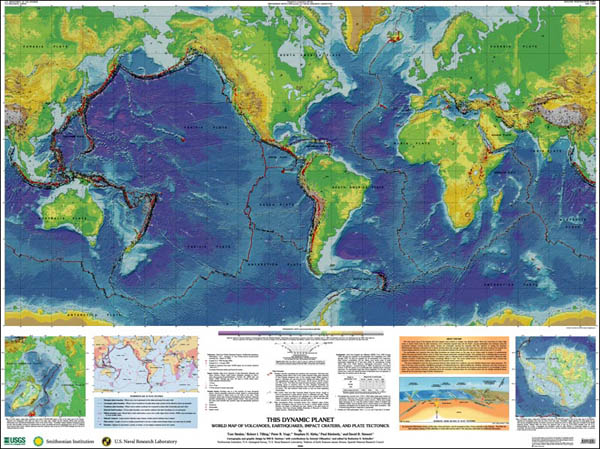Plate tectonics is a geological theory that describes the movement of the Earth’s lithosphere, which is the outermost layer of the Earth. This theory explains the distribution of continents, mountain ranges, ocean basins, earthquakes, and volcanic activity. Plate tectonics helps geologists understand the Earth’s history, predict natural disasters, and explore natural resources. This article explores the dynamic world of plate tectonics, its mechanism, and its impact on our planet.
The Birth of Plate Tectonics
The Early Theories of Continental Drift
The idea that continents move across the Earth’s surface was first proposed by Alfred Wegener in 1912. Wegener suggested that continents were once connected and drifted apart over millions of years. However, his theory was not widely accepted until the 1960s.
Discoveries of Mid-Ocean Ridges and Magnetic Stripes
In the 1950s, geologists discovered mid-ocean ridges, underwater mountain ranges that run through the Atlantic, Indian, and Pacific Oceans. They also found that rocks on either side of the ridges showed alternating magnetic stripes. This discovery led to the theory of seafloor spreading, which explained how new oceanic crust forms at the mid-ocean ridges and moves away from the ridge in opposite directions.
The Theory of Plate Tectonics
In the 1960s, the theory of plate tectonics was developed, which combined the ideas of continental drift and seafloor spreading. The theory suggests that the Earth’s lithosphere is divided into several plates that move and interact with each other at their boundaries. There are three types of plate boundaries: divergent, convergent, and transform.
The Mechanism of Plate Tectonics
Divergent Boundaries
At divergent boundaries, plates move away from each other, and new oceanic crust is formed. This process is called seafloor spreading. The Mid-Atlantic Ridge is an example of a divergent boundary.
Convergent Boundaries
At convergent boundaries, plates move towards each other, and one plate is subducted, or pushed beneath the other. This process is called subduction, and it causes volcanic activity and earthquakes. The Andes Mountains in South America and the Cascades in North America are examples of convergent boundaries.
Transform Boundaries
At transform boundaries, plates slide past each other horizontally, causing earthquakes. The San Andreas Fault in California is an example of a transform boundary.
The Impact of Plate Tectonics on Our Planet
Continental Drift
Plate tectonics explains the movement of continents, and how they were once connected in a supercontinent called Pangaea. The separation of continents caused the formation of new oceans and the evolution of new species.
Mountain Building
The collision of plates at convergent boundaries causes the formation of mountain ranges. The Himalayas, the Alps, and the Rocky Mountains are examples of mountain ranges formed by plate tectonics.
Volcanic Activity
The subduction of oceanic plates at convergent boundaries causes volcanic activity. The Ring of Fire, a region around the Pacific Ocean, is known for its active volcanoes and frequent earthquakes.
Earthquakes
The movement of plates causes stress on the Earth’s crust, which can lead to earthquakes. The San Andreas Fault in California is one of the most active earthquake zones in the world.
Conclusion
Plate tectonics is a dynamic process that shapes our planet. It explains the movement of continents, the formation of mountains, the occurrence of volcanic activity, and the occurrence of earthquakes. Understanding plate tectonics is crucial for predicting natural disasters and understanding plate tectonics is crucial for predicting natural disasters and exploring natural resources. This theory has revolutionized the field of geology and provided a better understanding of the Earth’s history and evolution.
Despite the advancements in technology, there are still many questions to be answered about plate tectonics. Scientists are still studying the mechanism of plate tectonics and its impact on the Earth’s climate and atmosphere. There is also ongoing research on how plate tectonics affects the formation of minerals and natural resources, such as oil and gas.
Plate tectonics is a dynamic and ever-changing process that shapes our planet. It is a reminder of the Earth’s power and the importance of understanding our planet’s processes. By continuing to study plate tectonics, we can gain a better understanding of the Earth’s history and evolution, and how we can protect our planet for future generations.
FAQs
- How does plate tectonics affect climate change? Plate tectonics can affect climate change in several ways, such as through volcanic activity and the release of carbon dioxide into the atmosphere. It also affects the distribution of continents and oceans, which can impact ocean currents and weather patterns.
- Can plate tectonics cause tsunamis? Yes, plate tectonics can cause tsunamis. Subduction of oceanic plates at convergent boundaries can cause underwater earthquakes that trigger tsunamis.
- How fast do plates move? Plates move at different rates depending on their location and type of boundary. Some plates move as fast as a few centimeters per year, while others move at a slower rate.
- Can plate tectonics reverse? The process of plate tectonics can slow down or stop, but it cannot reverse. However, the movement and interaction of plates can change over time due to various factors.
- What are the future implications of plate tectonics? Continued study of plate tectonics can provide a better understanding of natural disasters, natural resources, and the Earth’s climate and atmosphere. It can also inform decisions on land use, resource management, and disaster preparedness.
